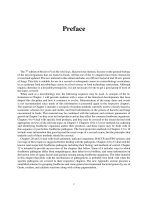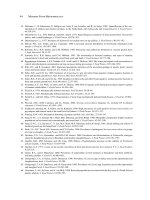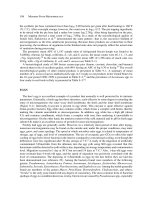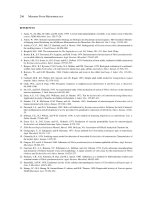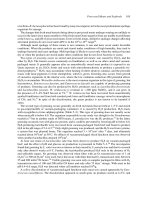Modern food microbiology 7th ed phần 41
Bạn đang xem bản rút gọn của tài liệu. Xem và tải ngay bản đầy đủ của tài liệu tại đây (77.65 KB, 5 trang )
192
Modern Food Microbiology
organism produced both bongkrekic acid and toxoflavin, as do the strains of B. cocovenenans in
bongkrek.
Ontjom (oncom) is a somewhat similar but more popular fermented product of Indonesia made from
peanut presscake, the material that remains after oil has been extracted from peanuts. The presscake
is soaked in water for about 24 hours, steamed, and pressed into molds. The molds are covered with
banana leaves and inoculated with Neurospora sitophila or R. oligosporus. The product is ready for
consumption 1 or 2 days later. A more detailed description of ontjom fermentation and the nutritive
value of this product has been provided by Beuchat.12
REFERENCES
1. Acton, J.C., R.L. Dick, and E.L. Norris. 1977. Utilization of various carbohydrates in fermented sausage. J. Food Sci.
42:174–178.
2. Acton, J.C., J.G. Williams, and M.G. Johnson. 1972. Effect of fermentation temperature on changes in meat properties and
flavor of summer sausage. J. Milk Food Technol. 35:264–268
3. Agate, A.D., and J.V. Bhat. 1966. Role of pectinolytic yeasts in the degradation of mucilage layer of Coffea robusta cherries.
Appl. Microbiol. 14:256–260.
4. Akinrele, I.A. 1970. Fermentation studies on maize during the preparation of a traditional African starch-cake food. J Sci.
Food Agric. 21:619–625.
5. Andersen, S.J. 1995. Compositional changes in surface mycoflora during ripening of naturally fermented sausages. J. Food
Protect. 58:426–429.
6. Arihara, K., H.Ota, M.Itoh, Y. Kondo, T. Sameshima, M. Akimoto, S. Kanai, and T. Miki. 1998. Lactobacillus acidophilus
group lactic acid bacteria applied to meat fermentation. J. Food Sci. 63:544–547.
7. Ayres, J.C., D.A. Lillard, and L. Leistner. 1967. Mold ripened meat products. In Proceedings of the 20th Annual Reciprocal
Meat Conference, 156–168. Chicago: National Live Stock and Meat Board.
8. Bacus, J. 1984. Utilization of Microorganisms in Meat Processing: A Handbook for Meat Plant Operators. New York:
John Wiley & Sons
9. Banigo, E.O.I., J.M. deMan, and C.L. Duitschaever. 1974. Utilization of high-lysine corn for the manufacture of ogi using
a new, improved processing system. Cereal Chem. 51:559–572.
10. Banigo, E.O.I., and H.G. Muller. 1972. Manufacture of ogi (a Nigerian fermented cereal porridge): Comparative evaluation
of corn, sorghum and millet. Can. Inst. Food Sci. Technol. J. 5:217–221.
11. Berwal, J.S., and D.Dincho. 1995. Molds as protective cultures for raw dry sausages. J. Food Protect. 58:817–819.
12. Beuchat, L.R. 1976. Fungal fermentation of peanut press cake. Econ. Bot. 30:227–234.
13. Bokanga, M. 1995. Biotechnology and cassava processing in Africa. Food Technol. 49:86–90.
14. Buckle, K.A., and E. Kartadarma. 1990. Inhibition of bongkrek acid and toxoflavin production in tempe bongkrek containing
Pseudomonas cocovenenans. J. Appl. Bacteriol. 68:571–576.
15. Cai, Y., H. Okada, H. Mori, Y. Benno, and T. Nakase. 1999. Lactobacillus paralimentarius sp. nov., isolated from soughdough. Int. J. Syst. Bacteriol. 49:1451–1455.
16. Camargo, R.de, J.Leme, Jr., and A.M. Filho. 1963. General observations on the microflora of fermenting cocoa beans
(Theobroma cacao) in Bahia (Brazil). Food Technol. 17:1328–1330.
17. Collard, P., and S. Levi. 1959. A two-stage fermentation of cassava. Nature 183:620–621.
18. Cummings, A., C. Reitmeier, L. Wilson, and B. Glatz. 2002. A survey of apple cider production practices and microbial
loads in cider in the state of Iowa. Dairy Fd. Environ. Sanit. 22:745–751.
19. Deibel, R.H., and C.F. Niven, Jr. 1957. Pediococcus cerevisiae: A starter culture for summer sausage. Bacteriol. Proc.
14–15.
20. Deibel, R.H.,C.F. Niven, Jr., and G.D. Wilson. 1961. Miccrobiology of meat curing. III. Some microbiological and related
technological aspects in the manufacture of fermented sausages. Appl. Microbiol. 9:156–161.
21. De Vuyst,L.V.Schrijvers, S.Paramithiotis, B. Hoste, M. Vancanneyt, J. Swings, G. Kalantzopoulos, E. Tsakalidou, and
W. Messens. 2002. The biodiversity of lactic acid bacteria in Greek traditional wheat sourdoughs is reflected in both
composition and metabolite formation. Appl. Environ. Microbiol. 68:6059–6069.
Nondairy Fermented Foods and Products
193
22. Dicks, L.M.T., F. Dellaglio, and M.D. Collins. 1995. Proposal to reclassify Leuconostoc oenos to Oenococcus oeni [corrig.].
gen. nov., comb. nov. Int. J. Syst. Bacteriol. 45:395–397.
23. Engelmann, U., and N. Weiss. 1985. Megasphaera cerevisiae sp. nov.: A new Gram-negative obligately anaerobic coccus
isolated from spoiled beer. Syst. Appl. Microbiol. 6:287–290.
24. Etchells, J.L., H.P. Fleming, and T.A. Bell. 1975. Factors influencing the growth of lactic acid bacteria during the fermentation of brined cucumbers. In Lactic Acid Bacteria in Beverages and Food, ed. J.G. Carr, C.V. Cutting, and G.C. Whiting,
281–305. New York: Academic Press.
25. Everson, C.W., W.E. Danner, and P.A. Hammes. 1970. Improved starter culture for semidry sausage. Food Technol. 24:42–
44.
26. Faparusi, S.I., and O. Bassir. 1971. Microflora of fermenting palm-wine. J. Food Sci. Technol. 8:206–210.
27. Filho, A.M., and C.W. Hesseltine. 1964. Tempeh fermentation: Package and tray fermentations. Food Technol. 18:761–765.
28. Fisher, T.L., and D.A. Golden. 1998. Fate of Escherichia coli 0157:H7 in ground apples used in cider production. J. Food
Protect. 61:1372–1374.
29. Frank, H.A., N.A. Lum, and A.S. Dela Cruz. 1965. Bacteria responsible for mucilage-layered composition in Kona coffee
cherries. Appl. Microbiol. 13:201–207.
30. Frank, H.A., and A.S. Dela Cruz. 1964. Role of incidental microflora in natural decomposition of mucilage layer in Kona
coffee cherries. J. Food Sci. 29:850–853.
31. Garc´ıa-Garc´ıa, P., R. Barranco, M.C. Dur´an Quintana, and A. Garrido-Fern´andez. 2004. Biogenic amine formation and
“zapatera” spoilage of fermented green olives: Effect of storage temperature and debittering process. J. Food Protect.
67:117–123.
32. Garc´ıa-Garc´ıa, P., M.Brenes-Balbuena, D. Hornero-M´endez, A. Garc´ıa-Borrego, and A. Garrido-Fern´andez. 2000. Content
of biogenic amines in table olives. J. Food Protect. 63:111–116.
33. Giolitti, G., C.A. Cantoni, M.A. Bianchi, and P. Renon. 1971. Microbiology and chemical changes in raw hams of Italian
type. J. Appl. Bacteriol. 34:51–61.
34. Gobbetti, M., and A. Corsetti. 1997. Lactobacillus sanfrancisco a key sourdough lactic acid bacterium: A review. Food
Microbiol. 14:175–187.
35. Greenwalt, C.J., K.H. Steinkraus, and R.A. Ledford. 2000. Kombucha, the fermented tea: Mcrobiology, composition, and
claimed health effects. J. Food Protect. 63:976–981.
36. Harris, D.A., L.Chaiet, R.P. Dudley, and P. Ebert. 1957. The development of commercial starter culture for summer sausages.
Bacteriol. Proc. Amer. Soc. Microbiol., 15.
37. Horn, S.J., I.M. Aasen, and K. ∅stgaard. 2000. Production of ethanol from mannitol by Zymobacter palmae. J. Ind.
Microbiol. Biotechnol. 24:51–57.
38. Ilany-Feigenbaum, J.J. Diamant, S. Laxer, and A. Pinsky. 1969. Japanese miso-type products prepared by using defatted
soybean flakes and various carbohydrate-containing foods. Food Technol. 23:554–556.
39. Kleyn, J., and J.Hough. 1971. The microbiology of brewing. Annu. Rev. Microbiol. 25:583–608.
40. Kline, L., and T.F. Sugihara. 1971. Microorganisms of the San Francisco sour dough bread process. II. Isolation
and characterization of undescribed bacterial species responsible for the souring activity. Appl. Microbiol. 21:459–
465.
41. Kunkee, R.E. 1975. A second enzymatic activity for decomposition of malic acid by malo-lactic bacteria. In Lactic Acid
Bacteria in Beverages and Food, ed. J.G. Carr, C.V. Cutting, and G.C. Whiting, 29–42. New York: Academic Press.
42. Levanon, Y., and S.M.O. Rossetini. 1965. A laboratory study of farm processing of cocoa beans for industrial use. J. Food
Sci. 30:719–722.
43. Lee, S.Y., M.S. Mabee, and N.O. Jangaard. 1978. Pectinatus, a new genus of the family Bacteroidaceae. Int. J. Syst.
Bacteriol. 28:582–594.
44. Liu, S.-Q. 2002. Malolactic fermentation in wine beyond deacidification. J. Appl. Microbiol. 92:589–601
45. Mislivec, P.B., V.R. Bruce, and R. Gibson. 1983. Incidence of toxigenic and other molds in green coffee beans. J. Food
Protect. 46:969–973.
46. Mukherjee, S.K., M.N. Albury, C.S. Pederson, A.G. van Veen, and K.H. Steinkraus. 1965. Role of Leuconostoc mesenteroides in leavening the batter of idli, a fermented food of India. Appl. Microbiol. 13:227–231.
47. Niinivaara, F.P., M.S. Pohja, and S.E. Komulainen. 1964. Some aspects about using bacterial pure cultures in the manufacture
of fermented sausages. Food Technol. 18:147–153.
48. Okafor, N. 1972. Palm-wine yeasts from parts of Nigeria. J. Sci. Food Agric. 23:1399–1407.
194
Modern Food Microbiology
49. Okafor, N. 1975. Microbiology of Nigerian palm wine with particular reference to bacteria. J. Appl. Bacteriol. 38:81–88.
50. Okafor, N. 1975. Preliminary microbiological studies on the preservation of palm wine. J. Appl. Bacteriol. 38:1–7.
51. Okamoto, T., H. Taguchi, K. Nakamura, H. Ikenaga, H. Kuraishi, and K. Yamasato. 1993. Zymobacter palmae gen. nov.,
sp. nov., a new ethanol-fermenting peritrichous bacterium isolated from palm sap. Arch. Microbiol. 160:333–337.
52. Palumbo, S.A., J.L. Smith, and S.A. Kerman. 1973. Lebanon bologna. I. Manufacture and processing. J. Milk Food Technol.
36:497–503.
53. Passmore, S.M., and J.G. Carr. 1975. The ecology of the acetic acid bacteria with particular reference to cider manufacture.
J. Appl. Bacteriol. 38:151–158.
54. Passos, F.M.L., D.O. Silva, A. Lopez, C.L.L.F. Ferreira, and W.V. Guimaraes. 1984. Characterization and distribution of
lactic acid bacteria from traditional cocoa bean fermentations in Bahia. J. Food Sci. 49:205–208.
55. Patel, I.B., and R.H. Vaughn. 1973. Cellulolytic bacteria associated with sloughing spoilage of California ripe olives. Appl.
Microbiol. 25:62–69.
56. Pearson, A.M., and T.A. Gillett. 1999. Processed Meats. New York: Kluwer Academic Publishers.
57. Pearson, A.M., and F.W. Tauber. 1984. Processed Meats, 2nd ed. New York: Kluwer Academic Publishers.
58. Pederson, C.S. 1979. Microbiology of Food Fermentations, 2nd ed. New York: Kluwer Academic Publishers.
59. Pederson, C.S., and R.S. Breed. 1946. Fermentation of coffee. Food Res. 11:99–106.
60. Pilone, G.J., and R.E. Kunkee. 1976. Stimulatory effect of malo-lactic fermentation on the growth rate of Leuconostoc
oenos. Appl. Environ. Microbiol. 32:405–408.
61. Plastourgos, S., and R.H. Vaughn. 1957. Species of Propionibacterium associated with zapatera spoilage of olives. Appl.
Microbiol. 5:267–271.
62. Potter, M.E., M.B. Kruse, M.A. Matthews, R.O. Hill, and R.J. Martin. 1976. A sausage-associated outbreak of trichinosis
in Illinois. Amer. J. Pub. Hlth. 66:1194–1196.
63. Radler, F. 1975. The metabolism of organic acids by lactic acid bacteria. In Lactic Acid Bacteria in Beverages and Food,
ed. J.G. Carr, C.V. Cutting, and G.C. Whiting, 17–27. New York: Academic Press.
64. Rainbow, C. 1975. Beer spoilage lactic acid bacteria. In Lactic Acid Bacteria in Beverages and Food, ed. J.G. Carr, C.V.
Cutting, and G.C. Whiting, 149–158. New York: Academic Press.
65. Reddy, N.R., S.K. Sathe, M.D. Pierson, and D.K. Salunkha. 1981. Idli, an Indian fermented food: A review. J. Food Qual.
5:89–101.
66. Roelofsen, P.A. 1958. Fermentation, drying, and storage of cacao beans. Adv. Food Res. 8:225–296.
67. Rohan, T.A., and T. Stewart. 1966. The precursors of chocolate aroma: Changes in the sugars during the roasting of cocoa
beans. J. Food Sci. 31:206209.
68. Răoling, W.F.M., and H.W. van Verseveld. 1996. Charcteristics of Tetragenococcus helophila populations of Indonesian soy
mash (kecap) fermentation. Appl. Environ. Microbiol. 62:1203–1207.
69. Rose, A.H. 1982. Fermented Foods. Economic Microbiology Series, 7. New York: Academic Press.
70. Saisithi, P., B.-O. Kasemsarn, J. Liston, and A.M. Dollar. 1966. Microbiology and chemistry of fermented fish. J. Food
Sci. 31:105–110.
71. Sanz, Y., and F. Toldra. 1998. Aminopeptidases from Lactobacillus sake affected by amines in dry sausages. J. Food Sci.
63:894–896.
72. Satomi, M., B. Kimura, M. Mizoi, T. Sato, and T. Fujii. 1997. Tetragenococcus muriaticus sp. nov., a new moderately
halophilic lactic acid bacterium isolated from fermented squid liver sauce. Int. J. Syst. Bacteriol. 47:832–836.
73. Schleifer, K.H., M. Leuteritz, N. Weiss, W. Ludwig, G. Kirchhof, and H. Seidel-Rufer. 1990. Taxonomic study of anaerobic,
Gram-negative, rodshaped bacteria from breweries: Emended description of Pectinatus cerevisiiphilus and description of
Pectinatus frisingensis sp. nov., Selenomonas lacticifex sp. nov., Zymophilus paucivorans sp. nov. Int. J. System. Bacteriol.
49:19–27.
74. Schwan, R.F. 1998. Cocoa fermentations conducted with a defined microbial cocktail inoculum. Appl. Environ. Microbiol.
64:1477–1483.
75. Semanchek, J.J., and D.A. Golden. 1996. Survival of Escherichia coli 0157:H7 during fermentation of apple cider. J. Food
Protect. 59:1256–1259.
76. Shieh, Y.-S.G., and L.R. Beuchat. 1982. Microbial changes in fermented peanut and soybean pastes containing kojis
prepared using Aspergillus oryzae and Rhizopus oligosporus. J. Food Sci. 47:518–522.
77. Smith, J.L., and S.A. Palumbo. 1973. Microbiology of Lebanon bologna. Appl. Microbiol. 26:489–496.
Nondairy Fermented Foods and Products
195
78. Steinkraus, K.H., A.G. van Veen, and D.B. Thiebeau. 1967. Studies on idli—An Indian fermented black gram-rice food.
Food Technol. 21:916–919.
79. Subik, J., and M. Behun. 1974. Effect of bongkrekic acid on growth and metabolism of filamentous fungi. Arch. Microbiol.
97:81–88.
80. Sugihara, T.F., L.Kline, and M.W. Miller. 1971. Microorganisms of the San Francisco sour dough bread process. I. Yeasts
responsible for the leavening action. Appl. Microbiol. 21:456–458.
81. Thompson, S.S., K.B. Miller, and A.S. Lopez. 2001. Cocoa and coffee. In Food Microbiology: Fundamentals and Frontiers,
2nd ed., ed. M.P. Doyle, L.R. Beuchat, and T.J. Montville, 721–733. Washington, DC: ASM Press.
82. Urbaniak, L., and W. Pezacki. 1975. Die Milchsăaure bildende Rohwurst-Mikroora und ihre technologisch bedingte
Verăanderung. Fleischwirts. 55:229237.
83. Van Pee, W., and J.M. Castelein. 1972. Study of the pectinolytic microflora, particularly the Enterobacteriaceae, from
fermenting coffee in the Congo. J. Food Sci. 37:171–174.
84. van Veen, A.G. 1967. The bongkrek toxins. In Biochemistry of Some Foodborne Microbial Toxins, ed. R.I. Mateles and
G.N. Wogan, 43–50. Cambridge, MA: MIT Press.
85. van Veen, A.G., and W.K. Mertens. 1934. Die Gifstoffe der sogenannten Bongkrek-vergiftungen auf Java. Rec. Trav. Chim.
53:257–268.
86. van Veen, A.G., and W.K. Mertens. 1934. Das Toxoflavin, der gelbe Gifstoff der Bongkrek. Rec. Trav. Chim. 53:398–404.
87. Vaughn, R.H. 1975. Lactic acid fermentation of olives with special reference to California conditions. In Lactic Acid
Bacteria in Beverages and Food, ed. J.G. Carr, C.V. Cutting, and G.C. Whiting, 307–323. New York: Academic Press.
88. Vaughn, R.H., T.Jakubczyk, J.D. MacMillan, T.E. Higgins, B.A. Dave, and V.M. Crampton. 1969. Some pink yeasts
associated with softening of olives. Appl. Microbiol. 18:771775.
89. Vogel, R.F., G. Băocker, P. Stolz, M. Ehrmann, D. Fanta, W. Ludwig, B. Pot, K. Kersters, K.H. Schleifer, and W.P. Hammes.
1994. Identification of lactobacilli from sourdough and description of Lactobacillus pontis sp. nov. Int. J. Syst. Bacteriol.
44:223–229.
90. Wardlaw, F.B., G.C. Skelley, M.G. Johnson, and J.C. Acton. 1973. Changes in meat components during fementation, heat
processing and drying of a summer sausage. J. Food Sci. 38:1228–1231.
91. Williamson, D.H. 1959. Studies on lactobacilli causing ropiness in beer. J. Appl. Bacteriol. 22:392–402.
92. Yaping, J., L. Xiaoyang, and Y. Jiaqi. 1990. Saccharobacter fermentatus gen. nov., sp. nov., a new ethanol-producing
bacterium. Int. J. Syst. Bacteriol. 40:412–414.
93. Yong, F.M., and B.J.B. Wood. 1974. Microbiology and biochemistry of the soy sauce fermentation. Adv. Appl. Microbiol.
17:157–194.
94. Zhao, N., C. Qu, E. Wang, and W. Chen. 1995. Phylogenetic evidence for the transfer of Pseudomonas cocovenenans (van
Damme et al. 1960) to the genus Burkholderia as Burkholderia cocovenenans (van Damme et al. 1960) comb. nov. Int. J.
Syst. Bacteriol. 45:600–603.
Chapter 9
Miscellaneous Food Products
This chapter contains brief descriptions of a wide variety of food products along with the microbial
biota of both fresh and spoiled products.
DELICATESSEN AND RELATED FOODS
Delicatessen foods, such as salads and sandwiches, are sometimes involved in food-poisoning
outbreaks. These foods are often prepared by hand, and this direct contact may lead to an increased
incidence of food-poisoning agents such as Staphylococcus. Once organisms such as these enter meat
salads or sandwiches, they may grow well because of the reduction in numbers of the normal food
biota by the prior cooking of salad ingredients.
In a study of retail salads and sandwiches, 36% of 53 salads were found to have total counts log10 /g
>6.00, but only 16% of the 60 sandwiches had counts as high.6 With respect to coliforms, 57% of
sandwiches were found to harbor log10 /g <2.00. S. aureus was present in 60% of sandwiches and 39%
of salads. Yeasts and molds were found in high numbers, with six samples containing log10 /g >6.00.
In a study of 517 salads from around 170 establishments, 71–96% were found to have aerobic plate
counts (APCs) log10 /g <5.00.45 Almost all (96–100%) salads contained coagulase positive S. aureus
at levels log10 /g <2.00. Salads included chicken, egg, macaroni, and shrimp. S. aureus was recovered
in low numbers from 6 to 64 salads in another study.12 The 12 different salads examined by these
investigators had total counts between log10 2.08 and 6.76, with egg, shrimp, and some of the macaroni
salads having the highest counts. Neither salmonellae nor C. perfringens were found in any product.
A study of 42 salads by Harris et al.18 revealed the products to be of generally good microbial quality.
The mean APC was log10 /g 5.54, and the mean coliform count was log10 2.66/g for the six different
products. Staphylococci were found in some products, especially ham salad.
Fresh green salads (greens, mixed greens, and coleslaw) were found to contain mean total counts of
log10 6.67 for coleslaw to log10 7.28 for green salads.13 Fecal coliforms were found in 26% of mixed,
28% of green, and 29% of coleslaw, whereas the respective percentage findings for S. aureus were
8, 14, and 3. With respect to parsley, E. coli was found on 11 of 64 samples of fresh and unwashed
products and on over 50% of frozen samples.24 The mean APC of fresh washed parsley was 7.28/g
log. Neither salmonellae nor S. aureus was found in any sample.
In a study of the microbiological quality of imitation-cream pies from plants operated under poor
sanitary conditions, Surkiewicz56 found that the microbial load increased successively as the products
were carried through the various processing steps. For example, in one instance, the final mixture of
197

